
Spanish moss is an epiphytic flowering plant that often grows upon larger trees in tropical and subtropical climates, native to much of Mexico, Bermuda, the Bahamas, Central America, South America, the Southern United States, West Indies and is also naturalized in Queensland (Australia). It is known as "grandpas beard" in French Polynesia. In the United States from where it is most known, it is commonly found on the southern live oak and bald-cypress in the lowlands, swamps, and marshes of the mid-atlantic and southeastern United States from southeastern Virginia to Florida and west to Texas and southern Arkansas.

A swamp is a forested wetland. Swamps are considered to be transition zones because both land and water play a role in creating this environment. Swamps vary in size and are located all around the world. The water of a swamp may be fresh water, brackish water, or seawater. Freshwater swamps form along large rivers or lakes where they are critically dependent upon rainwater and seasonal flooding to maintain natural water level fluctuations. Saltwater swamps are found along tropical and subtropical coastlines. Some swamps have hammocks, or dry-land protrusions, covered by aquatic vegetation, or vegetation that tolerates periodic inundation or soil saturation. The two main types of swamp are "true" or swamp forests and "transitional" or shrub swamps. In the boreal regions of Canada, the word swamp is colloquially used for what is more correctly termed a bog, fen, or muskeg. Some of the world's largest swamps are found along major rivers such as the Amazon, the Mississippi, and the Congo.

Senecio vulgaris, often known by the common names groundsel and old-man-in-the-spring, is a flowering plant in the daisy family Asteraceae. It is an annual herb, native to Europe and widely naturalised as a ruderal species in suitable disturbed habitats worldwide.
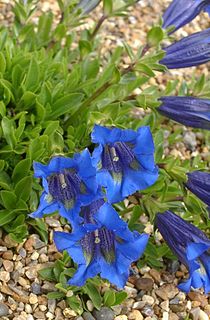
Gentianaceae is a family of flowering plants of 103 genera and about 1600 species.

Hibiscus tiliaceus is a species of flowering tree in the mallow family, Malvaceae, that is native to the Old World tropics. Common names include sea hibiscus, beach hibiscus, coastalhibiscus, coastalcottonwood, green cottonwood, native hibiscus, native rosella, cottonwood hibiscus, kurrajong, sea rosemallow, balibago (Tagalog), malabago or malbago, maribago, waru (Javanese), baru or bebaru (Malay), pagu (Chamorro), hau (Hawaiian), fau (Samoan), purau (Tahitian), and vau tree. The specific epithet, "tiliaceus", refers to its resemblance of the leaves to those of the related Tilia species.
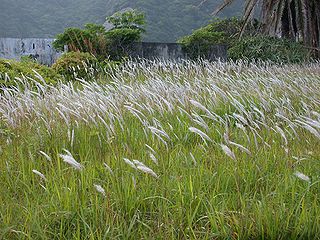
Imperata cylindrica ) is a species of perennial rhizomatous grass native to tropical and subtropical Asia, Micronesia, Melanesia, Australia, Africa, and southern Europe. It has also been introduced to Latin America, the Caribbean, and the southeastern United States. It is a highly flammable fire-adapted species, and can spread rapidly by colonizing disturbed areas and encouraging more frequent wildfires.
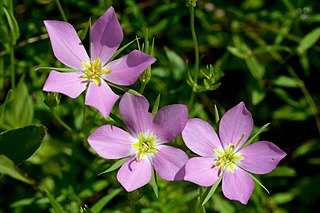
Sabatia campestris is a species of Sabatia, native to the south-central United States, from Texas east to Mississippi and north to Iowa and Illinois. It is also locally naturalized in New England.

Schinus terebinthifolia is a species of flowering plant in the cashew family, Anacardiaceae, that is native to subtropical and tropical South America. It is found in these states of Brazil: Alagoas, Bahia, Espírito Santo, Mato Grosso do Sul, Minas Gerais, Paraíba, Pernambuco, Paraná, Rio de Janeiro, Rio Grande do Norte, Rio Grande do Sul, Santa Catarina, São Paulo, and Sergipe. Common names include Brazilian peppertree, aroeira, rose pepper, broadleaved pepper tree, wilelaiki, Christmasberry tree and Florida holly. The species name has been very commonly misspelled as "terebinthifolius", due to considerable historic confusion as to the correct gender of the genus name; as of 2015 this has been resolved with the determination that the correct gender of Schinus is feminine, and adjectival names within the genus must be spelled accordingly.

Sabatia stellaris, with the common names rose of Plymouth, marsh pink, salt-marsh pink, and sea-pink; is a species of Sabatia. It has the Syn. Sabatia maculata (Benth.) Benth. & Hook.f., Sabatia palmeri Gray, Sabatia purpusii Brandeg., Sabatia simulata Britt.).

Sabatia angularis, commonly called rosepink, is a plant native to the eastern North America. It is geographically widespread and found in a variety of habitats, often in open areas.
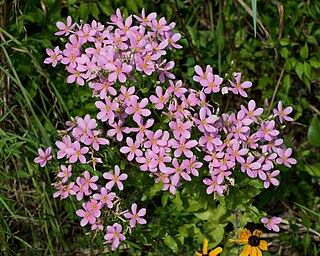
Sabatia, the rose gentians, is a genus of about 20 species of flowering plants in the family Gentianaceae, native to eastern and central North America, Central America, and the Caribbean.
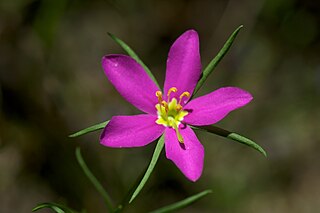
Sabatia arkansana, commonly known as Pelton’s rose gentian, is an herbaceous annual in the gentian family. It was discovered in 2001 in several glades of the Ouachita Mountains in Saline County, Arkansas by John Pelton, a retired mechanic turned amateur photographer and naturalist. It is known only from two locations in this county and is considered critically imperiled as a result of the presence of nearby housing developments and due to the absence of a fire regime. In summer it shows attractive rose-purple flowers.

The Gulf Stream, together with its northern extension the North Atlantic Drift, is a warm and swift Atlantic ocean current that originates in the Gulf of Mexico and stretches to the tip of Florida, and follows the eastern coastlines of the United States and Newfoundland before crossing the Atlantic Ocean as the North Atlantic Current. The process of western intensification causes the Gulf Stream to be a northwards accelerating current off the east coast of North America. At about 40°0′N30°0′W, it splits in two, with the northern stream, the North Atlantic Drift, crossing to Northern Europe and the southern stream, the Canary Current, recirculating off West Africa.

The Tusket River is a Canadian river located in Nova Scotia's Yarmouth County.

Christella normalis, synonym Thelypteris kunthii, sometimes known as Kunth's maiden fern or southern shield fern, is the most common of the maiden ferns in the southeastern United States south of the fall line. It ranges westward to eastern Texas. It usually grows in moist to dry terrestrial situations, but can also be epipetric. It often grows as a greenhouse escape in areas north of its usual range.

Sabatia kennedyana is a species of flowering plant in the gentian family known by the common name Plymouth rose gentian. It is native to eastern North America. It has a disjunct distribution, occurring in Nova Scotia, Massachusetts, Rhode Island, Virginia, North Carolina, and South Carolina.

Platanthera flava, the palegreen orchid, is a species of pale-flowered orchid. It is native to eastern North America, from Texas east to Florida, north to Ontario, Quebec and Nova Scotia.

Sabatia campanulata, commonly known as the slender rose gentian or slender marsh-pink, is an herbaceous plant in the gentian family. It is native to the primarily to the southeastern United States.

Sabatia brevifolia, commonly known as shortleaf or short-leaved rose gentian, narrowleaf or narrow-leaved sabatia, white marsh-pink or white sabatia, is a species of flowering plant in the genus Sabatia and the family Gentianaceae. It is an annual that grows in moist flatwoods and savannahs. It grows from 1-3 feet tall and the flowers have five white petals with pointed tips.

Sabatia grandiflora is a flowering plant in the genus Sabatia. Commonly known as marsh-pink or largeflower rose gentian, the annual has pink flowers. It grows in parts of Florida and Alabama. The flowers have five pink petals and a yellow center.






















